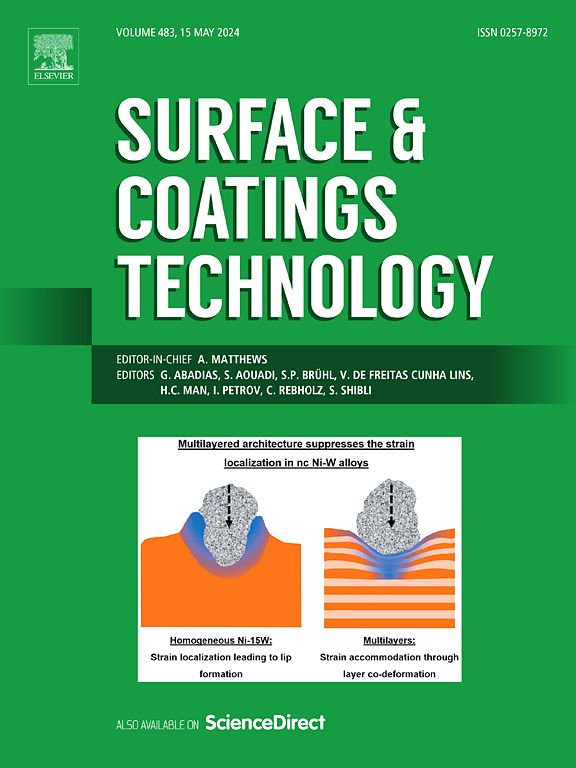利用化学沉积技术制造多功能铜涂层三聚氰胺泡沫,用于热管理、电磁干扰屏蔽和抗菌应用
IF 5.3
2区 材料科学
Q1 MATERIALS SCIENCE, COATINGS & FILMS
引用次数: 0
摘要
三聚氰胺泡沫(MF)因其燃烧时释放氮气的能力,本身就具有优异的阻燃性能。其多孔和疏松的结构也使其具有很高的柔韧性、透气性和吸音能力。加入纳米铜粒子(Cu NPs)可显著增强材料的导电性,包括电磁屏蔽效果、导热性和抗菌性。这反过来又大大拓宽了材料的潜在应用领域。本研究采用无电解化学沉积技术在三维 MF 上涂覆 Cu NPs,以制备多功能材料。随着 Cu NPs 含量从 0 g 增加到 0.31 g,电磁屏蔽效能(SET)增加到 85 dB。这些结果表明,Cu 涂层 MF 具有很高的电磁干扰屏蔽和导电性能。Cu NPs 与中频表面的强附着力形成了一种红外发射率低的涂层,从而使材料具有出色的隔热性能。在 4 V 左右的适度电源电压下,该材料表现出良好的导电性,通过高效焦耳加热产生高达 74 °C 的额外温度。此外,铜涂层中频材料显示出 100% 的抗菌活性,使其成为各种应用的理想候选材料。本文章由计算机程序翻译,如有差异,请以英文原文为准。

Fabrication of multifunctional cu-coated melamine foam by electroless chemical deposition technique for thermal management, EMI shielding, and antibacterial applications
Melamine foam (MF) inherently possesses excellent flame-retardant properties due to its ability to release nitrogen upon combustion. Its porous and loose structure also contributes to its high flexibility, breathability, and sound absorption capabilities. Incorporating copper nanoparticles (Cu NPs) significantly enhances the material's electrical conductivity, including its electromagnetic shielding effectiveness, thermal conductivity, and antibacterial properties. This, in turn, greatly broadens the material's potential applications. This research investigated the coating of Cu NPs on three-dimensional MF using an electroless chemical deposition technique to fabricate multifunctional materials. The electromagnetic shielding effectiveness (SET) increased to 85 dB as the Cu NPs content rose from 0 to 0.31 g. Similarly, the electrical conductivity increased from 0.19 to 357 S/m. These results indicate that the Cu-coated MF has high EMI shielding and conductivity properties. The strong adhesion of the Cu NPs to the MF surface created a coating with low infrared emissivity, contributing to the material's excellent thermal insulation properties. With a modest supply voltage of around 4 V, the material exhibited promising electrical conductivity, generating additional warmth of up to 74 °C through efficient joule heating. Furthermore, the Cu-coated MF demonstrated 100 % antibacterial activity, making it a promising candidate for a variety of applications.
求助全文
通过发布文献求助,成功后即可免费获取论文全文。
去求助
来源期刊

Surface & Coatings Technology
工程技术-材料科学:膜
CiteScore
10.00
自引率
11.10%
发文量
921
审稿时长
19 days
期刊介绍:
Surface and Coatings Technology is an international archival journal publishing scientific papers on significant developments in surface and interface engineering to modify and improve the surface properties of materials for protection in demanding contact conditions or aggressive environments, or for enhanced functional performance. Contributions range from original scientific articles concerned with fundamental and applied aspects of research or direct applications of metallic, inorganic, organic and composite coatings, to invited reviews of current technology in specific areas. Papers submitted to this journal are expected to be in line with the following aspects in processes, and properties/performance:
A. Processes: Physical and chemical vapour deposition techniques, thermal and plasma spraying, surface modification by directed energy techniques such as ion, electron and laser beams, thermo-chemical treatment, wet chemical and electrochemical processes such as plating, sol-gel coating, anodization, plasma electrolytic oxidation, etc., but excluding painting.
B. Properties/performance: friction performance, wear resistance (e.g., abrasion, erosion, fretting, etc), corrosion and oxidation resistance, thermal protection, diffusion resistance, hydrophilicity/hydrophobicity, and properties relevant to smart materials behaviour and enhanced multifunctional performance for environmental, energy and medical applications, but excluding device aspects.
 求助内容:
求助内容: 应助结果提醒方式:
应助结果提醒方式:


